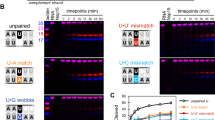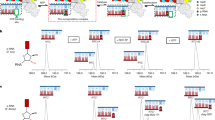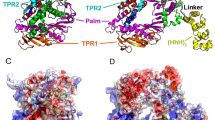Abstract
Akin to a 'Trojan horse,' APOBEC3G DNA deaminase is encapsulated by the HIV virion. APOBEC3G facilitates restriction of HIV-1 infection in T cells by deaminating cytosines in nascent minus-strand complementary DNA. Here, we investigate the biochemical basis for C → U targeting. We observe that APOBEC3G binds randomly to single-stranded DNA, then jumps and slides processively to deaminate target motifs. When confronting partially double-stranded DNA, to which APOBEC3G cannot bind, sliding is lost but jumping is retained. APOBEC3G shows catalytic orientational specificity such that deamination occurs predominantly 3′ → 5′ without requiring hydrolysis of a nucleotide cofactor. Our data suggest that the G → A mutational gradient generated in viral genomic DNA in vivo could result from an intrinsic processive directional attack by APOBEC3G on single-stranded cDNA.
This is a preview of subscription content, access via your institution
Access options
Subscribe to this journal
Receive 12 print issues and online access
$209.00 per year
only $17.42 per issue
Buy this article
- Purchase on SpringerLink
- Instant access to full article PDF
Prices may be subject to local taxes which are calculated during checkout







Similar content being viewed by others
References
Sheehy, A.M., Gaddis, N.C., Choi, J.D. & Malim, M.H. Isolation of a human gene that inhibits HIV-1 infection and is suppressed by the viral Vif protein. Nature 418, 646–650 (2002).
Kobayashi, M., Takaori-Kondo, A., Miyauchi, Y., Iwai, K. & Uchiyama, T. Ubiquitination of APOBEC3G by an HIV-1 Vif-Cullin5-Elongin B-Elongin C complex is essential for Vif function. J. Biol. Chem. 280, 18573–18578 (2005).
Conticello, S.G., Harris, R.S. & Neuberger, M.S. The Vif protein of HIV triggers degradation of the human antiretroviral DNA deaminase APOBEC3G. Curr. Biol. 13, 2009–2013 (2003).
Beale, R.C. et al. Comparison of the differential context-dependence of DNA deamination by APOBEC enzymes: correlation with mutation spectra in vivo. J. Mol. Biol. 337, 585–596 (2004).
Suspene, R. et al. APOBEC3G is a single-stranded DNA cytidine deaminase and functions independently of HIV reverse transcriptase. Nucleic Acids Res. 32, 2421–2429 (2004).
Yu, Q. et al. Single-strand specificity of APOBEC3G accounts for minus-strand deamination of the HIV genome. Nat. Struct. Mol. Biol. 11, 435–442 (2004).
Lecossier, D., Bouchonnet, F., Clavel, F. & Hance, A.J. Hypermutation of HIV-1 DNA in the absence of the Vif protein. Science 300, 1112 (2003).
Harris, R.S. et al. DNA deamination mediates innate immunity to retroviral infection. Cell 113, 803–809 (2003).
Mangeat, B. et al. Broad antiretroviral defence by human APOBEC3G through lethal editing of nascent reverse transcripts. Nature 424, 99–103 (2003).
Zhang, H. et al. The cytidine deaminase CEM15 induces hypermutation in newly synthesized HIV-1 DNA. Nature 424, 94–98 (2003).
Jarmuz, A. et al. An anthropoid-specific locus of orphan C to U RNA-editing enzymes on chromosome 22. Genomics 79, 285–296 (2002).
Huthoff, H. & Malim, M.H. Cytidine deamination and resistance to retroviral infection: Towards a structural understanding of the APOBEC proteins. Virology 334, 147–153 (2005).
Harris, R.S. & Liddament, M.T. Retroviral restriction by APOBEC proteins. Nat. Rev. Immunol. 4, 868–877 (2004).
Xie, K. et al. The structure of a yeast RNA-editing deaminase provides insight into the fold and function of activation-induced deaminase and APOBEC-1. Proc. Natl. Acad. Sci. USA 101, 8114–8119 (2004).
Navarro, F. et al. Complementary function of the two catalytic domains of APOBEC3G. Virology 333, 374–386 (2005).
Luo, K. et al. Amino-terminal region of the human immunodeficiency virus type 1 nucleocapsid is required for human APOBEC3G packaging. J. Virol. 78, 11841–11852 (2004).
Hache, G., Liddament, M.T. & Harris, R.S. The retroviral hypermutation specificity of APOBEC3F and APOBEC3G is governed by the C-terminal DNA cytosine deaminase domain. J. Biol. Chem. 280, 10920–10924 (2005).
Shindo, K. et al. The enzymatic activity of CEM15/Apobec-3G is essential for the regulation of the infectivity of HIV-1 virion but not a sole determinant of its antiviral activity. J. Biol. Chem. 278, 44412–44416 (2003).
Chiu, Y.L. et al. Cellular APOBEC3G restricts HIV-1 infection in resting CD4+ T cells. Nature 435, 108–114 (2005).
Berg, O.G., Winter, R.B. & von Hippel, P.H. Diffusion-driven mechanisms of protein translocation on nucleic acids. 1. Models and theory. Biochemistry 20, 6929–6948 (1981).
Halford, S.E. & Marko, J.F. How do site-specific DNA-binding proteins find their targets? Nucleic Acids Res. 32, 3040–3052 (2004).
Stanford, N.P., Szczelkun, M.D., Marko, J.F. & Halford, S.E. One- and three-dimensional pathways for proteins to reach specific DNA sites. EMBO J. 19, 6546–6557 (2000).
von Hippel, P.H. & Berg, O.G. Facilitated target location in biological systems. J. Biol. Chem. 264, 675–678 (1989).
Bransteitter, R., Pham, P., Scharff, M.D. & Goodman, M.F. Activation-induced cytidine deaminase deaminates deoxycytidine on single-stranded DNA but requires the action of RNase. Proc. Natl. Acad. Sci. USA 100, 4102–4107 (2003).
Creighton, S., Bloom, L.B. & Goodman, M.F. Gel fidelity assay measuring nucleotide misinsertion, exonucleolytic proofreading, and lesion bypass efficiencies. Methods Enzymol. 262, 232–256 (1995).
Zhou, H.X. A model for the mediation of processivity of DNA-targeting proteins by nonspecific binding: dependence on DNA length and presence of obstacles. Biophys. J. 88, 1608–1615 (2005).
Bransteitter, R., Pham, P., Calabrese, P. & Goodman, M.F. Biochemical analysis of hypermutational targeting by wild type and mutant activation-induced cytidine deaminase. J. Biol. Chem. 279, 51612–51621 (2004).
Pham, P., Bransteitter, R., Petruska, J. & Goodman, M.F. Processive AID-catalysed cytosine deamination on single-stranded DNA simulates somatic hypermutation. Nature 424, 103–107 (2003).
Bertram, J.G., Bloom, L.B., O'Donnell, M. & Goodman, M.F. Increased dNTP binding affinity reveals a nonprocessive role for Escherichia coli beta clamp with DNA polymerase IV. J. Biol. Chem. 279, 33047–33050 (2004).
Acknowledgements
We are grateful for the extensive expert advice provided by P. von Hippel and D. Astumian. We would like to thank R. Bransteitter for generating baculovirus expressing GST-APOBEC3G. This work was supported by US National Institutes of Health grants ESO13192 and R37GM21422.
Author information
Authors and Affiliations
Corresponding author
Ethics declarations
Competing interests
The authors declare no competing financial interests.
Supplementary information
Supplementary Fig. 1
Deamination on substrates with 3 and 7 nt between two C targets (PDF 112 kb)
Supplementary Fig. 2
Processive deamination in the presence of competitor ssDNA (PDF 129 kb)
Supplementary Fig. 3
Processive deamination on 157-nt substrates (PDF 129 kb)
Supplementary Fig. 4
Processive deamination of hot spot and cold spots (PDF 143 kb)
Supplementary Table 1
List of synthetic oligonucleotides (PDF 138 kb)
Supplementary Methods
Synthesis of DNA substrates with internal γ-32P label (PDF 81 kb)
Rights and permissions
About this article
Cite this article
Chelico, L., Pham, P., Calabrese, P. et al. APOBEC3G DNA deaminase acts processively 3′ → 5′ on single-stranded DNA. Nat Struct Mol Biol 13, 392–399 (2006). https://doi.org/10.1038/nsmb1086
Received:
Accepted:
Published:
Issue Date:
DOI: https://doi.org/10.1038/nsmb1086



